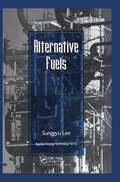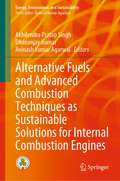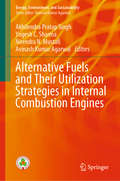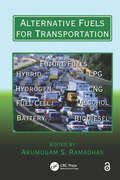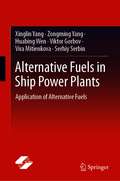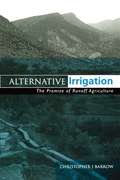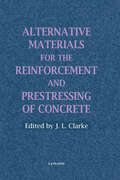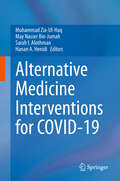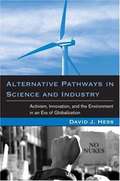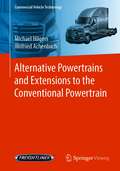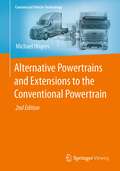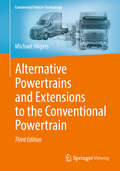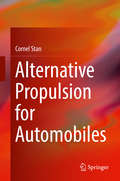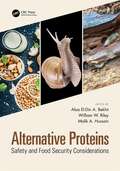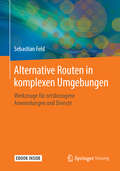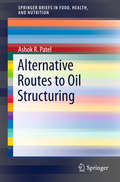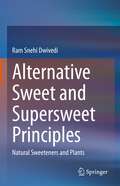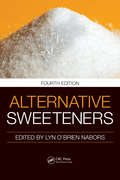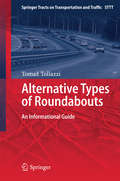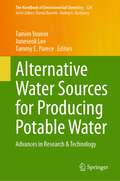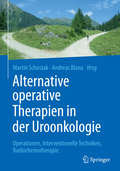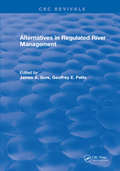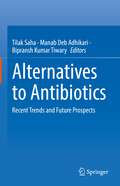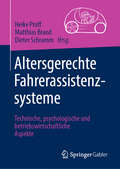- Table View
- List View
Alternative Fuels (Green Chemistry And Chemical Engineering Ser.)
by Sunggyu LeeEnvironmentally acceptable alternative fuels are in demand. This book dicusses the energy resources that are directly tied to the alleviation of petroleum dependence, and the science and technology in the area of alternative fuels. Various process treatments leading to cleaner and better use of existing fuel resources are discussed. This comprehensive reference book is consistent and is helpful for students and researchers.
Alternative Fuels and Advanced Combustion Techniques as Sustainable Solutions for Internal Combustion Engines (Energy, Environment, and Sustainability)
by Avinash Kumar Agarwal Akhilendra Pratap Singh Dhananjay KumarThis monograph covers different aspects related to utilization of alternative fuels in internal combustion (IC) engines with a focus on biodiesel, dimethyl ether, alcohols, biogas, etc. The focal point of this book is to present engine combustion, performance and emission characteristics of IC engines fueled by these alternative fuels. A section of this book also covers the potential strategies of utilization of these alternative fuels in an energy efficient manner to reduce the harmful pollutants emitted from IC engines. It presents the comparative analysis of different alternative fuels in a variety of engines to show the appropriate alternative fuel for specific types of engines. This book will prove useful for both researchers as well as energy experts and policy makers.
Alternative Fuels and Their Utilization Strategies in Internal Combustion Engines (Energy, Environment, and Sustainability)
by Yogesh C. Sharma Avinash Kumar Agarwal Akhilendra Pratap Singh Nirendra N. MustafiThis book covers alternative fuels and their utilization strategies in internal combustion engines. The main objective of this book is to provide a comprehensive overview of the recent advances in the production and utilization aspects of different types of liquid and gaseous alternative fuels. In the last few years, methanol and DME have gained significant attention of the energy sector, because of their capability to be utilized in different types of engines. This book will be a valuable resource for researchers and practicing engineers alike.
Alternative Fuels for Environmentally-Friendly Ships: Hydrogen, Ammonia, Bio-fuels and E-fuels (SpringerBriefs in Applied Sciences and Technology)
by Youngsub LimThis book reports on current shipping and shipbuilding industries' efforts for decarbonization. It demonstrates what regulations have been made for large ships on international voyages and points to what is to change in the future. The book also quantitatively reviews the current challenges of alternative fuels such as hydrogen, ammonia, biofuels, and e-fuels, considering economics, safety, and greenhouse gas emissions assessments.
Alternative Fuels for Transportation
by Arumugam S. RamadhasExploring how to counteract the world's energy insecurity and environmental pollution, this volume covers the production methods, properties, storage, engine tests, system modification, transportation and distribution, economics, safety aspects, applications, and material compatibility of alternative fuels. The esteemed editor highlights the importance of moving toward alternative fuels and the problems and environmental impact of depending on petroleum products. Each self-contained chapter focuses on a particular fuel source, including vegetable oils, biodiesel, methanol, ethanol, dimethyl ether, liquefied petroleum gas, natural gas, hydrogen, electric, fuel cells, and fuel from nonfood crops.
Alternative Fuels in Ship Power Plants: Application of Alternative Fuels
by Zongming Yang Huabing Wen Xinglin Yang Viktor Gorbov Vira Mitienkova Serhiy SerbinThis book describes the feasibility and status of the use of alternative fuels in marine engineering, as well as the application of liquefied natural gas, biodiesel and their blends as marine fuels, and the combustion of synthetic coal-based fuels.Each chapter in the book ends with a summary, which gives the reader a quick and clear understanding of the main contents of the chapter. The book gives a lot of advice on the selection of equipment and parameters, fuel reserves and preparation for scholars related to alternative fuels in ships, and points them in the way. It contains lots of illustrations and tables and explains it in the form of chart comparison. The authors have developed mathematical models and methods for calculating the parameters of fuel systems for biodiesel fuels and liquefied natural gas. Recommendations for choosing the rational parameters of these systems are given, as are schematic solutions of the fuel systems, recommendations for selecting equipment, storing, and preparing the fuels. Application of the materials described in the book provides the SPP designers with a reliable tool for choosing rational characteristics of the fuel systems operating on alternative fuels and improving the efficiency of their application on ships.
Alternative Irrigation: The Promise of Runoff Agriculture
by Christopher J BarrowAn introduction to runoff agriculture - a form of agricultural irrigation - this text describes how the use of surface and subsurface water, often overlooked and wasted, enables both small farmers and commercial agriculturists to improve yields and the security of harvest, even in harsh and remote environments. The text introduces the techniques and strategies, as well as the challenges and the potential of the crucial approach, which can contribute so much to reducing land degradation and improving conservation and sustainability.
Alternative Materials for the Reinforcement and Prestressing of Concrete
by John L. ClarkeCorrosion of steel reinforcement in concrete is a major problem, with serious implications for structural integrity and durability particularly for bridges and marine structures. This new book provides a thorough overview of recent developments and applications in this area.
Alternative Medicine Interventions for COVID-19
by Muhammad Zia-Ul-Haq May Nasser Bin-Jumah Sarah I. Alothman Hanan A. HenidiThis research volume examines the available alternative, complementary, pharmaceutical and vaccine methods for treating, mitigating, or preventing COVID-19. Coverage includes traditional Chinese medicine, herbal remedies, nutraceutical/dietary options, and drug/vaccine therapies. All the methods discussed will be critically examined to provide readers with a full, unbiased overview that includes pros/cons of each method. While the nature of COVID-19 is still being studied, and new research and theories are being published daily, this book endeavors to provide readers with a comprehensive summary of current research on alternative and mainstream treatment and prevention methods.
Alternative Pathways in Science and Industry: Activism, Innovation, and the Environment in an Era of Globalization
by David J. HessHess examines how social movements and other forms of activism affect innovation in science, technology, and industry. Hess explores the interaction of grassroots environmental action and mainstream industry and offers a conceptual framework for understanding it.
Alternative Powertrains and Extensions to the Conventional Powertrain (Commercial Vehicle Technology)
by Michael Hilgers Wilfried AchenbachThe aim of this work, consisting of 9 individual, self-contained booklets, is to describe commercial vehicle technology in a way that is clear, concise and illustrative. Compact and easy to understand, it provides an overview of the technology that goes into modern commercial vehicles. Starting from the customer's fundamental requirements, the characteristics and systems that define the design of the vehicles are presented knowledgeably in a series of articles, each of which can be read and studied on their own. This volume, "Alternative Powertrains and Supplements to the Conventional Powertrain", introduces alternatives and additions to the conventional powertrain of the commercial vehicle. The wide range of options is presented so as to be clearly understandable for those learning and working with them in a practical environment. Hybrid vehicles, electric powertrains and alternative fuels are discussed.
Alternative Powertrains and Extensions to the Conventional Powertrain (Commercial Vehicle Technology)
by Michael HilgersThe aim of this work, consisting of 9 individual, self-contained booklets, is to describe commercial vehicle technology in a way that is clear, concise and illustrative. Compact and easy to understand, it provides an overview of the technology that goes into modern commercial vehicles. Starting from the customer's fundamental requirements, the characteristics and systems that define the design of the vehicles are presented knowledgeably in a series of articles, each of which can be read and studied on their own. This volume, "Alternative Powertrains and Supplements to the Conventional Powertrain", introduces alternatives and additions to the conventional powertrain of the commercial vehicle. The wide range of options is presented so as to be clearly understandable for those learning and working with them in a practical environment. Hybrid vehicles, electric powertrains and alternative fuels are discussed.
Alternative Powertrains and Extensions to the Conventional Powertrain (Commercial Vehicle Technology)
by Michael HilgersThe aim of this work, consisting of 9 individual, self-contained booklets, is to describe commercial vehicle technology in a way that is clear, concise and illustrative. Compact and easy to understand, it provides an overview of the technology that goes into modern commercial vehicles. Starting from the customer's fundamental requirements, the characteristics and systems that define the design of the vehicles are presented knowledgeably in a series of articles, each of which can be read and studied on their own. This volume, "Alternative Powertrains and Supplements to the Conventional Powertrain", introduces alternatives and additions to the conventional powertrain of the commercial vehicle. The wide range of options is presented so as to be clearly understandable for those learning and working with them in a practical environment. Hybrid vehicles, electric powertrains and alternative fuels are discussed.
Alternative Propulsion for Automobiles
by Cornel StanThe book presents - based on the most recent research and development results worldwide - the perspectives of new propulsion concepts such as electric cars with batteries and fuel cells, and furthermore plug in hybrids with conventional and alternative fuels. The propulsion concepts are evaluated based on specific power, torque characteristic, acceleration behaviour, specific fuel consumption and pollutant emissions. The alternative fuels are discussed in terms of availability, production, technical complexity of the storage on board, costs, safety and infrastructure. The book presents summarized data about vehicles with electric and hybrid propulsion. The propulsion of future cars will be marked by diversity - from compact electric city cars and range extender vehicles for suburban and rural areas up to hybrid or plug in SUV´s, Pick up´s and luxury class automobiles.
Alternative Proteins: Safety and Food Security Considerations
by Alaa El-Din A. BekhitIn the last decade, there has been substantial research dedicated towards prospecting physiochemical, nutritional and health properties of novel protein sources. In addition to being driven by predictions of increased population and lack of a parallel increase in traditional protein sources, main drivers for the rise in novel proteins/ novel foods research activities is linked to significant changes in young consumers’ attitudes toward red meat consumption and their interest in new alternative protein products. Alternative Proteins: Safety and Food Security Considerations presents up-to-date information on alternative proteins from non-meat sources and examines their nutritional and functional roles as food sources and ingredients. Emphasis is placed on the safety of these novel proteins and an evaluation of their potential contribution to food security. Motivations for novel proteins and restrictions for their use are also discussed. Key Features: Explains potential improvements to alternative proteins through the employment of novel processing techniques. Contains the first review on keratin as an alternative protein source. Explores first comprehensive evaluation of the religious aspects of novel proteins. Describes methods for the detection and evaluation of health hazards. Discusses guidelines, regulatory issues and recommendations for food safety Additionally, this book covers fundamental and recent developments in the production of alternative proteins, and examines safety and consumer acceptability wherever information is available. The sources and processing options for alternative proteins and their impact on final product characteristics are also covered. A collective contribution from international researchers who are active in their field of research and have made significant contributions to the the food sciences, this book is beneficial to any researcher interested in the the food science and safety of alternative proteins.
Alternative Routen in komplexen Umgebungen: Werkzeuge für ortsbezogene Anwendungen und Dienste
by Sebastian FeldDas Buch zeigt verschiedene Ansätze und Verfahren, um alternative Routen in Freiflächen zu berechnen, geospatiale Trajektorien zu vergleichen sowie Strukturen in Gebäuden zu identifizieren. Die Wegefindung in komplexen Umgebungen unterscheidet sich von der in Straßennetzen vor allem dadurch, dass sich eine Person nahezu in alle Richtungen bewegen kann. Das Vorhalten von alternativen Routen für Fußgänger (aber auch für mobile Roboter) in Flughäfen, Krankenhäusern, Messehallen, Parks, Industrieanlagen oder Lagerhallen ermöglicht beispielsweise eine personalisierte Navigation, sodass proaktiv Stau vermieden oder blockierten Bereichen ausgewichen wird.Im ersten Teil des Buches definiert der Autor alternative Routen in komplexen Umgebungen, stellt den Algorithmus zum Berechnen solcher Routen vor und geht auf Qualitätsmetriken sowie Alternativgraphen ein. Im zweiten Teil legt Sebastian Feld unter anderem ein System zum Vergleich von Routen vor, mit dem aus einer Menge von Routen die extremsten Exemplare extrahiert werden können. Schließlich integriert er im dritten Teil des Buches die quantitative Analyse der visuellen Wahrnehmung von Raum in den Kontext alternativer Routen. Damit bietet das Buch einen Werkzeugkasten, der von weiteren ortsbezogenen Anwendungen und Diensten verwendet werden kann.
Alternative Routes to Oil Structuring (SpringerBriefs in Food, Health, and Nutrition)
by Ashok R. PatelThis Springer Brief gives an overview of recent research conducted in the area of oil structuring starting with a detailed introduction on oleogelation and properties of food-approved building blocks followed by the discussion of some illustrative examples to explain the processing steps required for creating oleogels, advanced characterization (rheological, thermal and microstructural) and some potential edible applications of oleogels. The book w concludes with a section summarizing the general guidelines on the properties of oleogels and practically of approach with regards to the specific category of building blocks used for structuring. The text also lists some unresolved challenges that need to be addressed in order to fully exploit oleogelation for future food product development. The functional application of liquid oils in food product development is mostly accomplished by structuring them into soft, plastic-like materials. This structuring of oil is traditionally based on the fat crystal network formed by high melting triacylglycerol (TAG) molecules that are rich in trans and/or saturated fatty acids. Currently, due to the factors such as the requirement for trans- and saturated fat-free food products, sustainable manufacturing and ethical trade practices, the research in the area of identifying alternative routes to oil structuring (in the absence of trans and saturated fats) has been regarded as a 'hot topic' in the bio-scientific community. Oleogelation (gelling of liquid oil in absence of crystallizable TAGs) is one such alternative, which has recently attracted tremendous attention from researchers and industrial scientists working in the domain of food product development. The possibility of creating structured gels that contain a large amount of liquid oil (usually above 90 wt%) opens up many possibilities to develop food products with better nutritional profiles.
Alternative Sweet and Supersweet Principles: Natural Sweeteners and Plants
by Ram Snehi DwivediThis book compiles the latest information on different kinds of natural, plant-based super sweeteners. A book on alternative, natural super sweeteners is extremely timely and useful, especially, in light of the decreasing cultivable area, ever increasing demand for sucrose, and the well identified ills of sugar consumption. Every year more than 5.0 million people die due to diabetes and diabetes-associated diseases like cardiovascular, kidney disorder, liver cancer etc. This book describes the use of non-saccharide super sweet principles to counter such maladies. The readers will get an in-depth understanding of different kinds of sweeteners, molecular basis of sweetness, their general classification, plant source with photo-plates etc. The chapters explain different kinds of super-sweet principles. This book emphasizes on the propagation, cultivation and conservation of NSSS plants (NSSSP) and extraction of super sweet principles and granting of generally recognised as safe (GRAS) certificate to sweeteners. The concluding chapter describes the eco-physiological difference between saccharide super sweet and non saccharide sweet plants. The book also describes commercial production of selected potential Natural Super Sweeteners. This book will be of great interest to researchers, extension workers as well as postgraduate students in Food science nutrition, ayurveda, plant physiology, Unani, naturopathy, biochemistry and plant breeding. It would also be of interest to industry stakeholders in sweetener industry and alternative sweetener manufactures.
Alternative Sweeteners
by Lyn O’Brien NaborsThe fourth edition of Alternative Sweeteners follows the same formula as the previous three books by discussing each sweetener in terms of its characteristics. Qualities covered include means of production, physical characteristics, utility, and relative sweetness (compared to sucrose). Technical qualities covered include admixture potential, application, availability, shelf life, transport, metabolism, carcinogenicity, and other toxicity evaluation data. A new chapter on the sweetener Advantame has been added, and new contributors have updated information throughout the book. Also new is a section on how stevia sweeteners have been examined and deemed safe by the Joint FAO/WHO Expert Committee on Food Additives and the US FDA.
Alternative Types of Roundabouts: An Informational Guide (Springer Tracts on Transportation and Traffic #6)
by Tomaž TollazziThis book presents a history of roundabouts, an introduction to their design, calculations of their capacity and traffic-safety features. It describes the key features of standard roundabouts and their limitations. Alternative types of roundabouts are a fairly recent development and have only been implemented in a few countries to date. The book illustrates a broad variety of these recent alternative types of roundabouts, as well as proposed types still in the development phase, explaining for each the specific needs it meets, its advantages and drawbacks. In closing, the book offers an outlook on the role of roundabouts in future street traffic.
Alternative Water Sources for Producing Potable Water: Advances in Research & Technology (The Handbook of Environmental Chemistry #124)
by Tamim Younos Tammy E. Parece Juneseok LeeDuring the third decade of the 21st century, communities across the world are being challenged with water scarcity both in rural and urban areas. Another significant problem is the energy demand for producing potable water. Our recent book “Resilient Water Management Strategies in Urban Settings: Innovations in Decentralized Water Infrastructure Systems” (Springer; 2022) introduced various facets of decentralized water infrastructure and the significant need for a shift toward using locally available alternative water sources. The proposed volume will expand on the concept and use of alternative water sources; rainwater, stormwater, wastewater/greywater, saline waters, and atmospheric water. Use of alternative water sources for potable purposes is a critical emerging research and technology area. In our knowledge such a book does not exist at this time. This volume will be a significant resource for researchers and graduate level teaching, and serve as a roadmap for water resource engineers and planners tackling water scarcity and diverse water resources portfolios.
Alternative operative Therapien in der Uroonkologie: Operationen, Interventionelle Techniken, Radiochemotherapie
by Martin Schostak Andreas BlanaNeue Wege in der operativen Uroonkologie! Dieses Buch beschreibt besondere operative Verfahren in ihren Einsatzfeldern von der praktischen Durchf#65533;hrung bis zu ihrer Stellung in der Literatur und den Leitlinien. Dar#65533;ber hinaus geben die ausgewiesenen Experten Hinweise, wie solche Operationen praktisch, m#65533;glichst risikoarm und effektiv zu gestalten seien. Im Spannungsfeld zwischen den Radikaltherapien auf der einen Seite und dem vor#65533;bergehenden Nichtbehandeln auf der anderen Seite suchen viele Betroffene nach sogenannten alternativen Therapien. Dabei handelt es sich um Verfahren, welche als noch nicht standardisiert gelten. Ziel soll eine m#65533;glichst gleichwertige Krebstherapie bei weniger Invasivit#65533;t bzw. besserem Erhalt der Lebensqualit#65533;t sein. Unter anderem finden sich folgende Themen im Buch: #65533; Hochintensiver fokussierter Ultraschall (HIFU) #65533; Kryotherapie #65533; Tookad #65533; Brachytherapie #65533; Alternative Therapien bei Nierenzellkarzinom, Urothelkarzinom und Hodenkarzinom
Alternatives in Regulated River Management
by James A. GoreResearchers and managers of regulated river systems will find this volume useful in acquiring information for deciding an integrated management plan for regulated river operations. Rather than the ecological theory of impacts of flow regulation, emphasis has been placed on methods to predict water quality and habitat alterations, as well as techniques to mitigate impacts from various operational scenarios. Although most chapters refer to impacts of riverine impoundments, these alternatives apply to any regulated situation in which changes in water quality or flow pattern occur. The predictive modeling techniques are explained primarily from a theoretical background. However, extensive bibliographies can guide the uninitiated to specific texts and software. Where controversial techniques have been presented, alternate methods are also described. Major topic areas include water quality problems, channel modification and management, ecological modeling and management, as well as a section on perspectives for ecological management and special problems in developing nations.
Alternatives to Antibiotics: Recent Trends and Future Prospects
by Tilak Saha Manab Deb Adhikari Bipransh Kumar TiwaryThis book discusses prospective alternative approaches to fight bacterial infections to minimize the indiscriminate use of conventional antibiotics. It offers the current knowledge on research and development of alternative antibacterial agents such as probiotics, nanobiotics etc. while it also discusses newly emerging trends such as phage therapy, antibody therapy etc. The book highlights on the phytochemicals with potent antibacterial activities as alternatives to conventional antibiotics. Chemical modification to develop next generation antibiotics with enhanced efficacy has also been included. Such modifications are reported to overcome the inherent resistance of the parent antibiotics. Phage therapy and targeted antibodies are considered as potential alternative approaches to treat bacterial ailments and represent areas of cutting-edge research and have therefore been discussed with sufficient care. Mainly, the book highlights various approaches other than conventional antibiotics in treating bacterial infections. The scientific advancements in these areas will strengthen the ‘One Health’ approach benefiting human beings, animals and environment as well. This book is a comprehensive resource to cater researchers, biological scientists, herbalists and clinical practitioners with up-to-date information on antibacterials other than antibiotics.
Altersgerechte Fahrerassistenzsysteme: Technische, psychologische und betriebswirtschaftliche Aspekte
by Dieter Schramm Heike Proff Matthias BrandMenschen in hoch entwickelten Ländern werden immer älter. Sie möchten im Alter mobil sein, haben jedoch oftmals Probleme im Straßenverkehr. Auch wenn sie häufig für altersgerechte Produkte, die die Sicherheit erhöhen, einen Aufpreis bezahlen, ist die Nachfrage nach Fahrerassistenzsystemen bei älteren Autofahrern bislang gering. Das Buch fasst Ergebnisse des Projektes ALFASY (ALtersgerechte FAhrerassistenzSYsteme) zusammen, in dem ein akustisches Fahrerassistenzsystem für die Bedürfnisse der stetig wachsenden Gruppe der älteren Fahrerinnen und Fahrer (50 Jahre und älter) entwickelt und aufgebaut wird. Untersucht wurden technische, psychologische und betriebswirtschaftliche Aspekte.
